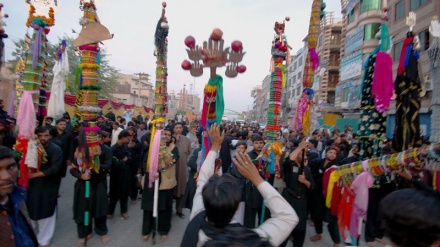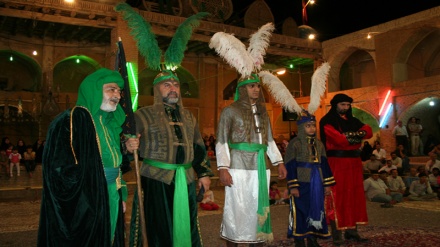Muharram mourning traditions in different lands - 20
In this series, which delves into the various mourning traditions associated with the Immortal Epic of Ashura in various lands, we look at the history of mourning for Imam Husain (AS).
Here we will briefly try, considering the flow of Islamic Revolution and the statements of revolutionaries and leaders of Iranian people’s movement, to examine the role and influence of Ashura and its components inclusive of the mourning ceremonies, the culture of martyrdom, constant struggle against falsehood, and enjoining good and prohibition of evil acts on genesis and victory of Iranian Islamic Revolution. The first sparks of Islamic Revolution were essentially lit in Muharram.
The uprising of 5 June 1963, a milestone in the history of Islamic Revolution, occurred subsequent to Imam Khomeini’s speech on the afternoon of Ashura (which fell on June 3 that year). The slogans chanted by people during this uprising and at the threshold of Islamic Revolution victory all referred to Ashura movement’s motifs. Although the massacre of June 5 apparently suppressed Imam’s movement, but the blood of martyrs and succeeding revelations and struggles prepared the public minds for a revolution. Ashura, as well, was apparently ended with martyrdom of Imam Husain (AS) and his companions, but indeed planted the seeds of great awakening movements and bore fruit. Imam Khomeini stated regarding the uprising of June 5:
“On that day (Ashura) Yazid and his hirelings dug their own graves and carved their brutality on the history forever, and so did the Pahlavi Regime, its rulers and advocates on June 5, and left eternal downfall and dishonor behind so that the honorable Iranian nation, will damn their graves with power and victory." (Sahife Noor, vol. 16, p. 79)
Due to his courageous revelations against the Pahlavi regime, Imam Khomeini was arrested and sent into exile in Turkey, from where he went to Iraq and took up residence near the holy shrine of the Commander of the Faithful, Imam Ali (AS). During his exile, by following the path of Imam Husain (AS), he remained patient and inspired by Ashura inculcated the spirit of religious fervor in the people. Disclosing the oppressions and corruptions of the regime, he called on people to rise against Yazid of the time and at the same time demanded establishment of an Islamic government and rule of Qur'anic values in the society. During that time he increasingly insisted on adherence to Imam Husain's (AS) movement and Islamic precepts, saying:
"Present Islam to people and in your presentations tread the path of Ashura… because “Muharram is the month in which the Master of Martyrs Imam Husain (AS) rose up against taghout to teach human beings construction and firmness. He did sacrifice and was sacrificed to annihilate the oppressor and the very same motif is the Islamic guideline for our nation forever.” (Sahife Noor, vol. 2, p. 11)
It is worth recalling that in the period between 1963 and 1979, during Muharram ceremonies in Iran, orations and speeches took revolutionary and political moods. Political attitude towards the events of Karbala and learning lessons from the Ashura Uprising became the salient features of the invitation of Imam Khomeini to the people of Iran. Ashura was not something remote in history, but the axis of mobilization against the Pahlavi regime. Iranian families portrayed their martyrs as offerings to God by the decree of Imam Husain of the time. Mosques and other religious places were regarded as the most significant bases for activities of revolutionary forces, informing people of the Pahlavi regime’s corruptions, and organizing them for revolutionary activities and demonstrations.
Influenced by Ashura, Iranian people recalled martyrdom-seeking and sacrifice spirit of Imam Husain (AS) and his companions and chanting slogans such as “Allahu Akbar” (God is the Greatest) and “tank, artillery, and machine gun has no other effect” confronted tanks and machine guns of Pahlavi Regime. Imam Khomeini repeatedly remarked: “the quality of the struggle, namely the way to rise against a powerful regime only with a limited number of people, is the lesson Imam Husain (AS) has given us."
Here, it ought to be pointed out that in the 1960s and 1970s in Iran, some preachers, ulema, and academicians dealt with Ashura and the mourning ceremonies from new angles thereby making the society, especially the youth, more familiar with this epoch-making movement of Imam Husain (AS). Ayatollah Morteza Motahari and Dr. Ali Shariati were more successful in this way. Through speeches and books such as “Hamaseye Husaini” (the epic of Imam Husain), Ayatollah Motahari reminded people, especially the youth, of the significance of the tragedy of Karbala in the revival of Islam and its anti-oppression dimensions. Dr. Shariati, as well, having recourse to his particular view was seeking to make the youth more acquainted with the movement of Imam Husain (AS) and his companions.
Perhaps the most important impression of Ashura culture and teachings on Iranian Islamic Revolution was opposition to taghout and arrogance as it was observed in all activities and stances of Imam Khomeini as a central motif of his Islamic movement. Just as Imam Husain (AS) refused to acknowledge Yazid’s rule and considered a usurper without any legitimate authority, Imam Khomeini repeatedly questioned the claim to legitimacy of the Pahlavi regime in his orations, statements, and interviews. From his exile in Iraq, he called on preachers and ulema to take full advantage of the mourning ceremonies of the months of Moharram and Safar, since these two months were the best time for disclosing the anti-Islamic policies of the Pahlavi regime.
As a result, the public rallies on the days of Tasua and Ashura in 1978 broke the back of the regime. Moreover, Imam Khomeini’s epochal statement on 10 February 1979 ordering people to defy the curfew- which aimed to arrest the leaders of Revolution and supposedly bring an end to it- was practically another Ashura epic. People poured into the streets and delivered the final blow on the worn body of the regime, and the Islamic Revolution, thanks to its inspiration from the Tragedy of Karbala, triumphed in Iran and ushered in Islamic rule.
MD/AS/SS


